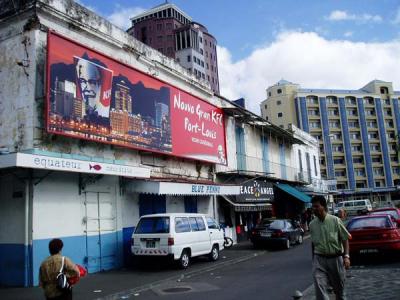During the past two years, several articles have been published in the local press on the Waqf Board Building (located near the Place d’Armes, Port-Louis) which unfortunately have paid little attention to the historical and heritage value of this important stone structure.
The Historical Value of the Building
The Waqf Board Building was constructed during the 1820s and 1830s on the surviving stone structure of a late eighteenth century building which was heavily damaged during the Port Louis Fire of 1816. During its entire existence, the Waqf Board Building has been used as a commercial building. Between the 1860s and early 1900s, the ground level of the building was used as a shop which provided supplies to ships which docked in Port Louis harbour.
Between the 1880s and early 1900s, the first floor of the building was a small hotel known as L’Hotel L’Orient. During this period, it was one of the rare hotels located in the centre of the town of Port Louis. After all, the Waqf Board Building was situated in a key location next to the railway line passing through the heart of Port Louis and close to the Customs House, the Immigration Depot, the Civil Hospital and the Port Louis Central Market. Throughout the 20th century and until the present day, the ground level of the building has been occupied by small shops, while part of the first level was used as a storage area.
The Waqf Board Building is one of the most important buildings in the Aapravasi Ghat World Heritage Site Buffer Zone, along with the Central Post Office, the Labourdonnais Hospital, the Port Louis Central Market and the Granary. The Waqf Board Building is considered by the Aapravasi Ghat Trust Fund to be a Grade 1 building which means that it has a great historical and heritage value and needs to be protected and restored and not demolished. In other words, it forms an integral part of “the ensemble of historic buildings” located along in the vicinity of the Aapravasi Ghat World Heritage Site.
This fact is well known to the Municipality of the City of Port Louis, the National Heritage Fund and the Ministry of Arts and Culture. The Waqf Board Building, which was acquired many years ago by the Islamic Cultural Association, exemplifies a specific type of colonial architecture which existed in the Aapravasi Ghat Buffer Zone and the business centre of Port Louis during the first half of the 19th century.
The Heritage Value of the Building
The historical and heritage value of this building was mentioned in the Aapravasi Ghat World Heritage Site Nomination Dossier in 2005, the Aapravasi Ghat Management Plan and the Planning Policy Guidance of the Aapravasi Ghat Buffer Zone. The historical importance of the Waqf Board Building has also been mentioned repeatedly in the reports of Professor Karel Bakker, an internationally known South African urban landscape expert and consultant for the Aapravasi Ghat Planning Policy Guidance.
It was also highlighted by Nicholas Clarke, a South African architect and consultant, who worked on a detailed report on the grading of historical buildings in the Aapravasi Ghat Buffer Zone. Hopefully, in the coming months, the National Heritage Fund will decree the Waqf Board Building a national heritage and, at the same time, it will also be given added legal protection under the Aapravasi Ghat Buffer Zone Planning Policy Guidance.
PRESERVING OUR BUILT HERITAGE : The Historical and Heritage Value of the Waqf Board Building
- Publicité -
EN CONTINU ↻


